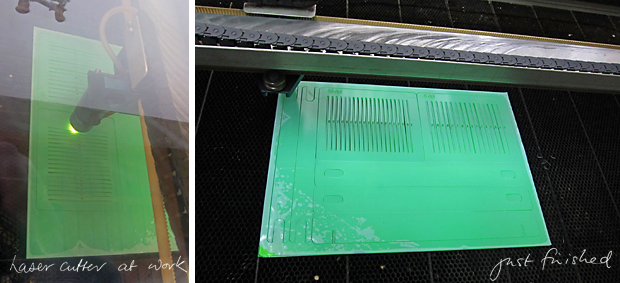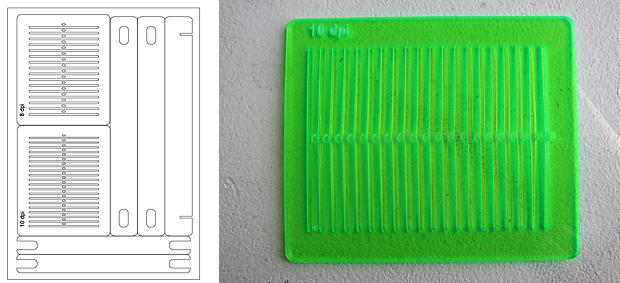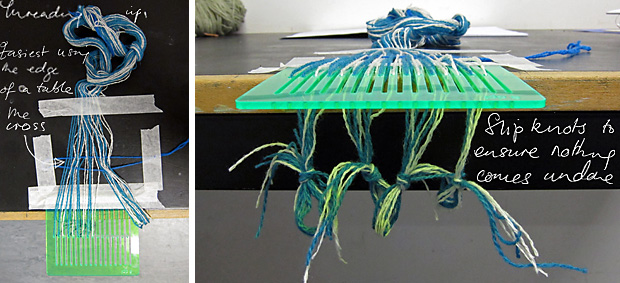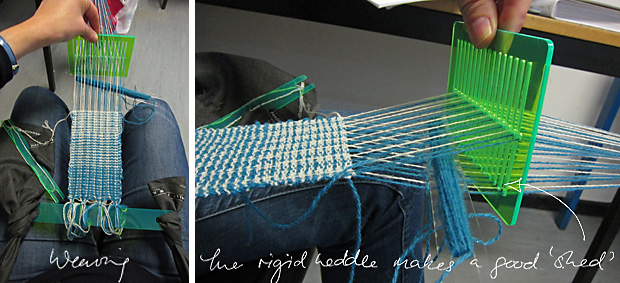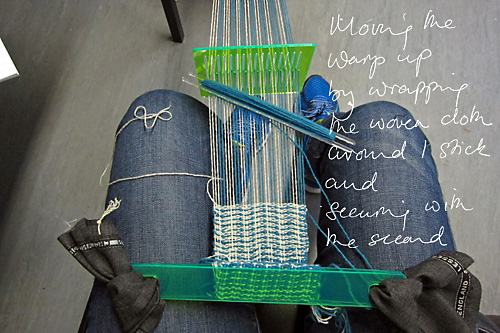Rigid heddles have their roots in ancient civilisations. You can use them to make a back-strap loom, which will allow you to weave anywhere. One end of the warp is tied to a handy tree or table leg, and the other end is tied to a stick, that in turn is tied to a strap around your back. You use your body weight to tension the loom.
Because of their portability rigid heddles are an ideal way to introduce people to weaving – and as part of the Z-Twist education programme I will be using the laser cutter at Somerset College to make about 30 rigid heddles to teach community groups and schools how to weave.

Rigid heddles in the Pitt Rivers Museum, Oxford. On the left a rigid heddle band loom from Zuni, New Mexico, USA, made from wooden laths tied to sticks, with a wool warp and a wooden sword for beating in (you can see the tip of the sword poking out under the heddle). On the right decorated rigid heddles from Europe, top from Auvergne, France, and below from Abruzzi, Italy.
A rigid heddle is made up of alternating slots and holes, through which the warp is threaded. The Pitt Rivers Museum in Oxford has an interesting collection of rigid heddles from around the world made from a variety of materials. Using a laser cutter to make rigid heddles is not new, Travis Meinolf, the Action Weaver, first made some as part of his Masters in 2008 and is now selling laser cut plywood rigid heddle kits.
Designing my rigid heddles I automatically fell back on my weaving training and started thinking about the density of the cloth we will be making, the yarn, how close or far away each warp thread should be to the next, and what it is possible to cut without weakening the final rigid heddle too much.
The first test on some spare scrap (above). The laser both cuts and engraves (left) but my design was not robust enough at the edge. On the reverse you can see the laser is too hot and has melted the cut edges.
My second test on an A4 piece of 3mm green, fluorescent-tinted acrylic.
The acrylic comes with a protective film on both sides – the film has burnt but underneath the acrylic is fine.
The laser cutter uses Adobe Illustrator (a vector-based drawing package) files to tell it where to cut. I am trying to make maximum use of the material (left), making sticks for tying the warp on to and securing around your waist, and stick shuttles for weaving in the weft. I tested an 8 dpi (dents or holes per inch) and a 10 dpi rigid heddle. The 10 dpi with more slots/holes is looking fragile; there is not enough acrylic between the holes and the slots. I also thought about two designs of stick – the slot design (far right stick in the left image) is a no-go, the acrylic is not flexible enough to slot into another parallel stick – plus the slot is only 2mm wide and the acrylic is 3mm thick…
Trying out the 8 dpi rigid heddle using 2/11.3 nm “supersoft” lambswool I made a short 1m warp with the legs of two upturned chairs.
Threading the rigid heddle is easiest using masking tape and the edge of a table.
Weaving with the rigid heddle, the far end of the warp is attached to a table leg out-of-shot and the other end is tied to the stick which is also tied around my waist with a piece of cloth from the scrap bins. It weaves well, making a good gap or ‘shed’ between the slots and holes, for the shuttle to pass through. Perhaps a little more space at the top would be useful for holding on to.
I am using two colours for my warp, arranged in a particular order, and then using the same colours again in the weft, woven in a chosen order to get a ‘colour-and-weave’ patterned effect.
As you weave the rigid heddle gets further and further away from you, so every so often you need to wind the woven cloth around one stick and secure it with a second stick to be able to weave comfortably. The holes in the sticks could be a little larger.
A successful test – I will make a couple of tweaks to the design but essentially I am ready to cut more. The main problem is timing; it took 40 minutes to cut an A4 piece of acrylic with 2 rigid heddles – I want to move on to A3 pieces with more rigid heddles, but the laser cutting slots at Somerset College are only 1 hour long. I need to look at minimising cuts …

